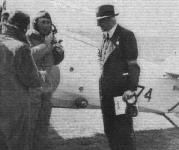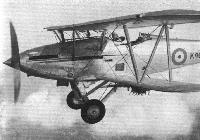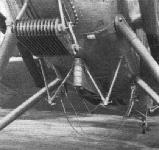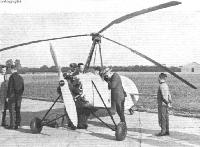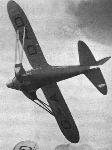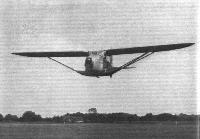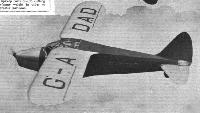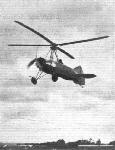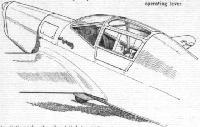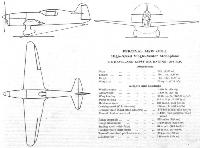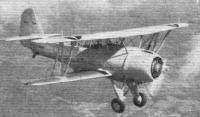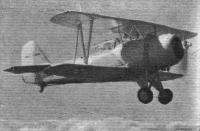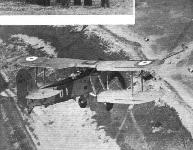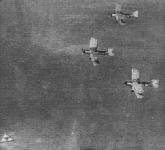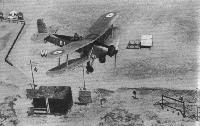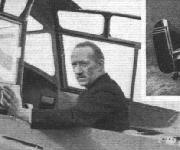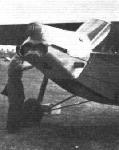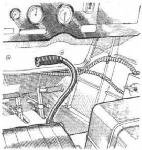Фотографии
-
Регистрационный номер: R258Y, NX258Y A "MOVIE" MONOPLANE. This is the new racing machine built (by an unknown manufacturer) for Mr. Howard Hughes, the American film director. It will attack the landplane speed record. The engine appears to be a two-row Pratt and Whitney or Wright. The arrangement of the retractable undercarriage is interesting.
Самолёты на фотографии: Hughes H-1 - США - 1935
-
Sir Philip Cunliffe-Lister removes his helmet after arriving on Saturday in a Hawker Hart of the Communications Squadron. He is chatting with Lord Gorell, chairman of the Royal Aero Club.
Самолёты на фотографии: Hawker Hart - Великобритания - 1928
-
Регистрационный номер: G-ADLO A Reading type well represented - the Hawk Major; seven of these machines - two of which, differing from the others in internal fittings, are more accurately described as Hawk Trainers - are taking part.
Самолёты на фотографии: Miles Hawk / M.2 - Великобритания - 1932
-
Регистрационный номер: G-ACTE The Miles Hawk Speed Six (Gipsy Six) which will be flown by W. Humble
Самолёты на фотографии: Miles Hawk / M.2 - Великобритания - 1932
-
Регистрационный номер: G-ADMW, DG590 Toeing the line on Friday. In the foreground, on the left, is Diana Mary Williams' Percival Gull, piloted by T. W. Morton; on the right is A. C. W. Norman's Miles Hawk.
Самолёты на фотографии: Miles Hawk / M.2 - Великобритания - 1932Percival Gull - Великобритания - 1932
-
Регистрационный номер: G-ADLN Second home in the Final - R Cornwall's Miles Hawk Trainer (Gipsy Major), flown by Flt. Lt. H. R. A. Edwards
Самолёты на фотографии: Miles Hawk / M.2 - Великобритания - 1932
-
Mr. Charles Powis and Mr. F. G. Miles talk it over with Mr. F. N. St. Barbe, De Havilland business manager.
Самолёты на фотографии: Miles Hawk / M.2 - Великобритания - 1932
-
Регистрационный номер: G-ADLB Third component of the Reading hat-trick Major Allen's Hawk Trainer (Gipsy Major), piloted by Owen Cathcart Jones.
Самолёты на фотографии: Miles Hawk / M.2 - Великобритания - 1932
-
The Adventuri, otherwise the super-venturi which Miss Fontes could place in the air-stream to drive blind-flying instruments in the event of her Hawk Speed Six striking bad weather.
Самолёты на фотографии: Miles Hawk / M.2 - Великобритания - 1932
-
Регистрационный номер: I-ZENA AN INTERNATIONAL AFFAIR: The scene at Littorio (Rome) Aerodrome, Italy, at the start of the recent International meeting for a flight round Italy. The first lap was to Naples. A Miles Falcon is in the foreground.
Самолёты на фотографии: Miles Falcon M.3 / Hawcon M.6 - Великобритания - 1934
-
Регистрационный номер: G-ADLC [2] The victorious Miles Falcon (Gipsy Six) snapped as it swooped across the line, winner of the final at 176.28 m.p.h.
Самолёты на фотографии: Miles Falcon M.3 / Hawcon M.6 - Великобритания - 1934
-
Регистрационный номер: G-ADLC [2] "Leading-in the winner" of the King's Cup is as much a rite as leading in the winner of the Derby.
Самолёты на фотографии: Miles Falcon M.3 / Hawcon M.6 - Великобритания - 1934
-
A cut-away view of the cabin of the machine which, in the hands of Flt. Lt. Rose, won the King's Cup at 176.28 m.p.h. Providing comfort better than that of the majority of motor cars, the Falcon's upholstery (by Rumbold) is extremely pleasing. Among the instruments can be seen the Sestrel compass, Reid and Sigrist turn indicator, and an array of Smith's aircraft instruments. On the left of the control column is the flap-operating lever, and in front are those for brakes and tail trim.
Самолёты на фотографии: Miles Falcon M.3 / Hawcon M.6 - Великобритания - 1934
-
THE SHAPE OF THINGS GONE BY: A faithful copy ot the Wright biplane glider' of 1902 has been made by Zander and Weyl, of Dunstable, for use in the film Conquest of the Air. Mr. A. R. Weyl is here seen - we almost said "in the cockpit" - just prior to a launching.
Самолёты на фотографии: Wright Glider - США - 1900
-
Регистрационный номер: G-EBLQ In this Jaguar-engined Armstrong-Whitworth (or Siddeley) Siskin Barnard averaged 141 m.p.h. round a 1,626-mile course in 1925.
Самолёты на фотографии: Armstrong Whitworth Siskin - Великобритания - 1921
-
Самолёты на фотографии: Handley Page Heyford / H.P.38 / H.P.50 - Великобритания - 1930
-
Самолёты на фотографии: Handley Page Heyford / H.P.38 / H.P.50 - Великобритания - 1930
-
The Shelvoke & Drewry engine-driven tail-wheel trolley, for moving machines about on the ground.
Самолёты на фотографии: Handley Page Heyford / H.P.38 / H.P.50 - Великобритания - 1930
-
Some of the Handley Page Heyfords (Rolls-Royce Kestrels) of No 10 (Bomber) Squadron.
Самолёты на фотографии: Handley Page Heyford / H.P.38 / H.P.50 - Великобритания - 1930
-
This stern view of the Martin B-10 reveals its remarkably fine line.
Самолёты на фотографии: Martin B-10 / Type 139 / 166 - США - 1932
-
The B-10 has lately been mounted on a pair of Edo floats with a view to attacking certain seaplane records.
Самолёты на фотографии: Martin B-10 / Type 139 / 166 - США - 1932
-
CHINA SAW ITS FIRST AUTOGIRO when Flt. Lt. A. D. Bennett, R.A.F.O., of Aircraft (China) Ltd., recently gave demonstrations of a direct-control model in Shanghai and other large towns. The machine was eventually taken over by the Chinese Central Government Air Force for trial. In the photograph above are (left to right) Marshal Chiang Hsu Liang, his chief of staff, and Flt. Lt. Bennett.
Самолёты на фотографии: Cierva/Avro C.30A / Rota - Великобритания - 1932
-
Most of the cars and a few of the aeroplanes present at the opening display. The big machine is the British Continental D.H. 86 and the Autogiro has its full parking equipment in place. The future control building will probably be built on the boundary at the top of the Picture.
Самолёты на фотографии: Cierva/Avro C.30A / Rota - Великобритания - 1932De Havilland Express Air Liner / D.H.86 - Великобритания - 1934
-
DEADLIER THAN THE MALE. Another remarkable "close-up" of the Hawker Hind. A very large batch of these machines is being produced by the Hawker Company. The fully supercharged Kestrel V will come as a treat to pilots who have been flying Harts with naturally aspirated engines.
Самолёты на фотографии: Hawker Hind - Великобритания - 1934
-
A WAY THEY HAVE IN THE STATES. Vought Corsairs (of two types) flying over Cleveland, Ohio, the scene of the 1935 National Air Races. The car park speaks volumes for the enthusiasm of the American public for really fast air racing.
Самолёты на фотографии: Vought O2U/O3U/V-65/V-93 Corsair - США - 1926
-
The Blackburn torpedo gear as fitted to the Shark.
Самолёты на фотографии: Blackburn Shark / B-6 - Великобритания - 1933
-
The general arrangement of the Blackburn torpedo carrier, showing the disposition of the crutches, slings, stop plate, etc. Mechanical or electrical release gear may be used.
Самолёты на фотографии: Blackburn Shark / B-6 - Великобритания - 1933
-
Group Capt. Saul and crew of a Singapore of No. 203 (F.B.) Squadron.
Самолёты на фотографии: Short Singapore III / S.19 - Великобритания - 1934
-
FOR THE NETHERLANDS INDIES: These three D.H. Rapides are to be used for aerial survey work by the Netherlands New Guinea Petroleum Company. One is to be fitted with a P.B. automatic pilot.
Самолёты на фотографии: De Havilland Dragon Rapide / Dominie / D.H.89 - Великобритания - 1934
-
WHAT POLAND WANTED. Bristol Pegasus III moderately supercharged radials rated at 690 h.p have been installed in a pair of Douglas D.C.2's for the Polskie Linje Lotnicze, "Lot," one of which is shown here.
Самолёты на фотографии: Douglas DC-1 / DC-2 / C-32 / C-39 - США - 1933
-
PEGASUS-POWERED. The installation of 690 h.p. Pegasus III engines in a pair of Douglas D.C.2's for Poland has already been recorded in Flight. These views show the nose type exhaust ring and the cowling and it is also possible to see how the exhaust pipe is led into the nacelle.
Самолёты на фотографии: Douglas DC-1 / DC-2 / C-32 / C-39 - США - 1933
-
THE TIPSY "S" MONOPLANE, designed by Mr. E. O. Tips of the Fairey Aviation company in Belgium, and now fitted with an Aubier et Dunne two-stroke engine, which has increased the speed to 94 m.p.h. Avions Fairey are laying down six of these machines, which will probably be fitted with the 750 c.c. Douglas engine, these, it is calculated, should give approximately the same performance.
Самолёты на фотографии: Tipsy S - Бельгия - 1935
-
The experimental D.H. 90 (two Gipsy Majors), unfortunately scratched. It is the first D.H. biplane to appear with an unequal span since the experimental Airco 4R machine built for the Aerial Derby of 1919.
Самолёты на фотографии: De Havilland Dragonfly / D.H.90 - Великобритания - 1935
-
The Jubilee Monospar crosses the finishing line after averaging 122.5 m.p.h. in the hands of K. G. Seth-Smith
Самолёты на фотографии: General Aircraft Monospar ST-25 Universal - Великобритания - 1935
-
Регистрационный номер: G-ADPI BACK FROM THE CONTINENT: In this Monospar Jubilee model, recently purchased by the Vacuum Oil Company, Mr. W. Faust (director) and Mr. H. J. White (aviation sales manager and pilot have been touring their agencies in many countries on the Continent Mr. E. C. Gordon England, joint managing director of General Aircraft Ltd., the makers of the Monospar, was also on board.
Самолёты на фотографии: General Aircraft Monospar ST-25 Universal - Великобритания - 1935
-
Регистрационный номер: G-ADMV [3] Самолёты на фотографии: Hafner AR.III Gyroplane - Великобритания - 1935
-
Регистрационный номер: G-ADMV [3] Самолёты на фотографии: Hafner AR.III Gyroplane - Великобритания - 1935
-
Регистрационный номер: G-ADMV [3] Discussing the new A.R.III gyroplane: On the left is Capt. V. H. Baker, chief pilot to Airwork, Ltd., at Heston, and on the right is Mr. R. Hafner, designer of the machine.
Самолёты на фотографии: Hafner AR.III Gyroplane - Великобритания - 1935
-
Регистрационный номер: G-ADAD [2] Самолёты на фотографии: Heston Phoenix - Великобритания - 1935
-
LOW DRAG: Here ts the first British strutted monoplane to have a retractable undercarriage. The machine is the Heston Aircraft Company s Phoenix, and the feature, with the careful cowling of the Gipsy Six engine, gives a very "clean" appearance.
Самолёты на фотографии: Heston Phoenix - Великобритания - 1935
-
Регистрационный номер: G-ADAD [2] Самолёты на фотографии: Heston Phoenix - Великобритания - 1935
-
Самолёты на фотографии: Heston Phoenix - Великобритания - 1935
-
Регистрационный номер: G-ACVA KAY GYROPLANE IN THE AIR: Flt. Lt. A. H. Rawson flying the Kay Gyroplane at Southampton airport. This machine was first described in Flight of December 27, 1934. It has a unique method of varying the incidence of the blades end is undergoing tests for the Air Ministry.
Самолёты на фотографии: Kay Gyroplane - Великобритания - 1932
-
AN OPEN GULL. It will be agreed that this new open-cockpit two-seater Percival Gull is an extremely pretty aeroplane. Built for the Maharajah of Jodhpur, it is fitted with a Gipsy Six engine, electric starting, dual control and special tankage arrangements which give it a range of 800 miles.
Самолёты на фотографии: Percival Gull - Великобритания - 1932
-
C. S. Napier takes off with his Percival Gull, Cirrus Major which averaged 133.5 rn.p.h. in the final.
Самолёты на фотографии: Percival Gull - Великобритания - 1932
-
C. E. Gardner, in Peter Mursell's Gull, kept his map well under his nose ... and won the Siddeley Trophy.
Самолёты на фотографии: Percival Gull - Великобритания - 1932
-
Mr. C. S. Napier's Gull (Cirrus Major) flown by Flt. Lt. E. T. C. Edwards had this extra fuel tank in the cabin in place of the third passenger seat.
Самолёты на фотографии: Percival Gull - Великобритания - 1932
-
Регистрационный номер: G-ACND [2] OFFICIAL INTEREST. The Percival Mew Gull is the first aeroplane to exceed 200 m.p.h. in the King's Cup Air Race. The photograph shows it being examined at Hatfield with obvious interest by Lord Gorell, chairman of the Royal Aero Club, Sir Philip Cunlifle-Lister, Secretary of State for Air, and Lt. Col. Shelmerdine, Director-General of Civil Aviation.
Самолёты на фотографии: Percival Mew Gull - Великобритания - 1934
-
Регистрационный номер: G-ACND [2] First away on Friday the speedy Mew Gull; but on Saturday Capt. Percival had the arduous honour of starting last.
Самолёты на фотографии: Percival Mew Gull - Великобритания - 1934
-
Much in little, and quickly, too - one of the T.B. refuelling units supplying the Mew Gull.
Самолёты на фотографии: Percival Mew Gull - Великобритания - 1934
-
The Face at the Window is that of Capt. E. W. Percival (and why shouldn't one wear a respectable hat in a 215 m.p.h. aeroplane?)
Самолёты на фотографии: Percival Mew Gull - Великобритания - 1934
-
Interior view of the cabin of H.R.H. the Duke of Kent's Mew Gull, which Capt. Percival flew into sixth place at 208.91 m.p.h. On the left side of the cabin floor is the flap operating lever.
Самолёты на фотографии: Percival Mew Gull - Великобритания - 1934
-
Exterior view of the cabin of H.R.H. the Duke of Kent's Mew Gull, which Capt. Percival flew into sixth place at 208.91 m.p.h.
Самолёты на фотографии: Percival Mew Gull - Великобритания - 1934
-
The news that Lord Wakefield has presented to the R.Ae.C. a cheque tor L250 to be awarded to Capt E. W Percival as a special Prize in recognition of his performance in the King's Cup race lends interest to this general arrangement drawing and data - not generally known - of the Mew Gull. It will be recalled that, although he was not placed in the Final, Capt. Percival averaged 208.91 m.p.h. over the 350 miles and made the fastest lap of the day with a speed of 211.2 m.p.h. The machine was entered for the race by H.R.H. The Duke of Kent
Самолёты на фотографии: Percival Mew Gull - Великобритания - 1934
-
Регистрационный номер: G-ADNO [2] The T.K.2, built by students of the D.H. Technical School, makes a fast and clean take-off in the Final in the hands of Capt. Broad.
Самолёты на фотографии: De Havilland Technical School T.K.2 - Великобритания - 1935
-
Регистрационный номер: G-ADNO [2] As Lord Wakefield's entry, the T.K.2, designed and built by the De Havilland Technical School, will certainly be a centre of interest.
Самолёты на фотографии: De Havilland Technical School T.K.2 - Великобритания - 1935
-
Shape is maintained in the centre portion of the compression legs of the T.K.2 by coiled springs behind the fabric.
Самолёты на фотографии: De Havilland Technical School T.K.2 - Великобритания - 1935
-
A typically varied line-up of machines at Waalhaven In the right-hand lower corner is the new Hornet-engined Koolhoven.
Самолёты на фотографии: Koolhoven FK-50 - Нидерланды - 1935
-
The Luscombe Phantom at Heston. Note the undercarriage bracing and tne tunnel cowling.
Самолёты на фотографии: Luscombe Phantom - США - 1934
-
STEEPENING THE GLIDE: Electrically operated flaps, placed well inside the trailing edge, extend outwards almost to the wing tips in the Luscombe Phantom
Самолёты на фотографии: Luscombe Phantom - США - 1934
-
TRANSOCEANIC CONTRAST. This photograph, recently received from Para, Brazil, shows a B.A. Eagle in company with the famous Sikorsky S.42 Brazilian Clipper. The Eagle is that in which Senor Pombo, who is one of the group, flew the South Atlantic in 16 hr. 40 min. from Bathurst. The picture is of particular interest in view of the fact that the British Aircraft Manufacturing Company hold the rights of building the S.42 in England.
Самолёты на фотографии: British Klemm BK-1 Eagle - Великобритания - 1934Sikorsky S-42 Clipper - США - 1934
-
The flaps round the N.A.C A. cowling of tne Vought are an innovation.
Самолёты на фотографии: Vought F3U/SBU/V-142 - США - 1933
-
The pilot's "conservatory" can be seen.
Самолёты на фотографии: Vought F3U/SBU/V-142 - США - 1933
-
John Fox's Eagle, flown by Flt. Lt. J. B. Wilson, passing over the aerodrome at Hatfield.
Самолёты на фотографии: British Klemm BK-1 Eagle - Великобритания - 1934
-
A delightful type for private owners - the B.A. Eagle (Gipsy Major).
Самолёты на фотографии: British Klemm BK-1 Eagle - Великобритания - 1934
-
A neat sliding rear window in E. L. Gandar Dower's Eagle (pilot, Angus Irwin).
Самолёты на фотографии: British Klemm BK-1 Eagle - Великобритания - 1934
-
Регистрационный номер: G-ABWZ Самолёты на фотографии: De Havilland Puss Moth / D.H.80 - Великобритания - 1929
-
Регистрационный номер: NC14549 SEATING TWO, side by side, the American Aeronca is shortly to be built either at Hanworth or Aldenham, by Lightplanes Ltd. Mr. B. Brady has the British Empire manufacturing rights for this American design and, with the collaboration of J. A. Prestwich and Co , of motor cycle fame, who will build the engine, it is hoped to market it at ?395. The fuselage is of welded steel tubes and the wing of wood and metal. The cruising speed will be 85 m.p.h and range about 300 miles.
Самолёты на фотографии: Aeronca C - США - 1929
-
Регистрационный номер: G-ADSO [2] The "nasal" layout of the Aeronca is well shown in this photograph. The exhaust-warmed intake arrangements are noteworthy.
Самолёты на фотографии: Aeronca C - США - 1929
-
Регистрационный номер: G-ADSO [2] How the Aeronca may be manhandled. The machines are seen in front of the new Aircraft Exchange and Mart hangar at Hanworth.
The Aeronca C-3 was one of the lightest aircraft flown by the Civil Air Guard, having an all up weight of around 1,000 lb.Самолёты на фотографии: Aeronca C - США - 1929
-
A lady victorious: Commander Perrin shepherds in Miss Browns winning Avian at the conclusion of the 1930 contest.
Самолёты на фотографии: Avro Avian / Type 594/616 - Великобритания - 1926
-
Before last year's race: The Avro Avian (Genet Major), which is being flown this year by No. 36, A. H. Tweddle.
Самолёты на фотографии: Avro Avian / Type 594/616 - Великобритания - 1926
-
Регистрационный номер: G-ABME The line-up for the Final, with the only biplane, A. H. Tweddle's Avian (Armstrong-Siddeley Genet), in the foreground. Although fairly new to the racing game, Tweedle's flying was remarkably consistent in both Friday's and Saturday's races.
Самолёты на фотографии: Avro Avian / Type 594/616 - Великобритания - 1926
-
Регистрационный номер: G-ACKP A Typical Leopard Moth
Самолёты на фотографии: De Havilland Leopard Moth / D.H.85 - Великобритания - 1933
-
De-spatted and unpropped - Sir Derwent Hall-Caine's Leopard Moth, flown by Capt. Hope, receives ministrations on Thursday.
Самолёты на фотографии: De Havilland Leopard Moth / D.H.85 - Великобритания - 1933
-
"Shove her back": Airmen and seamen work together in moving a Baffin on the tarmac.
Самолёты на фотографии: Blackburn Baffin / B-5 - Великобритания - 1933
-
Регистрационный номер: K4078 A lineup of the Baffins of No. 810 (F.T.B.) Squadron together with their crews and all other ranks. The uniforms of Royal Navy, Royal Marines, and Royal Air Force make a curious contrast.
Самолёты на фотографии: Blackburn Baffin / B-5 - Великобритания - 1933
-
Officers, airmen, seamen, ana Marines ol No. 810 (F.T.B.) Squadron.
Самолёты на фотографии: Blackburn Baffin / B-5 - Великобритания - 1933
-
Регистрационный номер: K4071 [2] A Baffin pilot diving at a ground target and firing his front gun.
Самолёты на фотографии: Blackburn Baffin / B-5 - Великобритания - 1933
-
A flight of No. 810 Squadron about to bomb a target on the sands at North Coates Fitties.
Самолёты на фотографии: Blackburn Baffin / B-5 - Великобритания - 1933
-
Регистрационный номер: K4071 [2] A Blackburn Baffin (Bristol Pegasus engine) practising air firing with the rear gun at a target on the sands at North Coates Fitties.
Самолёты на фотографии: Blackburn Baffin / B-5 - Великобритания - 1933
-
Регистрационный номер: J7520 THE KING'S CUP WINNER: Flight-Lieut. R. L. Atcherley ("Llewellyn") on the Gloster "Grebe" (Armstrong-Siddeley "Jaguar") entered by Sir Walter Preston, starting from Heston, and (inset) "crossing the line." The second "Grebe," with its entrant, the Hon. F. E. Guest, as passenger, and piloted by F./O. E. H. Fielden, is seen in the background.
Самолёты на фотографии: Gloster Grebe - Великобритания - 1923
-
Well known at races are the Comper Swifts (Gipsy III).
Самолёты на фотографии: Comper Swift / CLA.7 - Великобритания - 1930
-
No. 20, Capt. W. L. Hope, and No. 21, R. O. Shuttleworth, are both flying Swifts.
Самолёты на фотографии: Comper Swift / CLA.7 - Великобритания - 1930
-
Tempering the wind - a deflector noticed on a Comper Swift.
Самолёты на фотографии: Comper Swift / CLA.7 - Великобритания - 1930
-
Регистрационный номер: G-EBVG VETERAN: The original Short Calcutta, which is now back at Rochester after seven and a half years on Imperial Airways Empire routes, and is being fitted with Armstrong-Siddeley Tiger engines preparatory to its use as a training machine for Imperial pilots.
Самолёты на фотографии: Short Calcutta / Rangoon / S.8 - Великобритания - 1928
-
Регистрационный номер: G-ACTC The Hendy Heck (Gipsy Six), now reported to be withdrawn.
Самолёты на фотографии: Parnall Hendy Heck - Великобритания - 1934
-
No. 3, Flt. Lt. R. Duncanson, seated in the Hendy Heck.
Самолёты на фотографии: Parnall Hendy Heck - Великобритания - 1934
-
Регистрационный номер: F-AKFK [2] The airtight compartment for the pilot of the F1001. It was served by a small centrifugal engine-driven supercharger, was cylindrical in shape, and had walls about an inch thick.
Самолёты на фотографии: Farman F.1000 - Франция - 1932
-
Регистрационный номер: F-AKFK [2] Разработанный для установления мирового рекорда высоты, Farman F.1001 унаследовал от неудачного F.1000 массивное крыло типичной для "Farman" конструкции и неубираемое шасси. На самолете установлен четырехлопастный винт изменяемого шага.
The F1001 was in no sense a pretty aeroplane. There seems little doubt, however, that had the crash not occurred it would have provided some extremely valuable data relevant to stratosphere flying.Самолёты на фотографии: Farman F.1000 - Франция - 1932
-
TRYING IT ON THE DESOUTTER. This is the brand new inverted six-cylinder "V" Monarch engine installed in a modified Desoutter for test purposes. The engine, which will be developed by Aero Engines Ltd., delivers 150 h.p. and weighs about 340 lb.
Самолёты на фотографии: Koolhoven FK-41 - Нидерланды - 1928
-
O. G. E. Roberts (right), pilot of the Monospar, checks his course calculations before tne Eliminating Contest.
Самолёты на фотографии: General Aircraft Monospar ST-4 - ST-12 - Великобритания - 1932
-
IN THE OFFICE: Mr. H. J. Stieger, designer of the "S.T.10," and Managing Director of General Aircraft Ltd., is here standing In the cockpit of the machine before the race started. Seated is Flt. Lt. H. M. Schofield, General Manager and Chief Pilot of the company. He flew the "S.T.10" throughout the race.
Самолёты на фотографии: General Aircraft Monospar ST-4 - ST-12 - Великобритания - 1932
-
The only entry of its type, the Monospar S.T.12 (two Gipsy Majors), may carry on the tradition of last year's winner. The pilot is O. G. E. Roberts.
Самолёты на фотографии: General Aircraft Monospar ST-4 - ST-12 - Великобритания - 1932
-
A neat ventilator built into one of the cabin windows of the Monospar,
Самолёты на фотографии: General Aircraft Monospar ST-4 - ST-12 - Великобритания - 1932
-
One of the Gipsy Major high-compression engines of the Monospar S.T.12, the only twin-motored machine in the race.
Самолёты на фотографии: General Aircraft Monospar ST-4 - ST-12 - Великобритания - 1932
-
Регистрационный номер: G-ADPJ [3] The B.A.C. Super Drone is an ultra light pusher type, in which the pilot has a very excellent view.
Самолёты на фотографии: Kronfeld Drone - Великобритания - 1932
-
Mr. Robert Kronfeld, managing director of B.A.C. (1935) Ltd., in the cockpit of the Super Drone. With him are Mr. E. C. Gordon England (director) and on the left, the latter's brother, Sqn. Ldr. T. H. England.
Самолёты на фотографии: Kronfeld Drone - Великобритания - 1932
-
Регистрационный номер: G-ADPJ [3] Not quite so startling as it appears - merely the Super Drone with its wings folded, thus reducing the width for housing purposes to 10 ft. Note the wide undercarriage.
Самолёты на фотографии: Kronfeld Drone - Великобритания - 1932
-
Регистрационный номер: G-ADPJ [3] A number of modifications, together with the use of a 750 c.c. Douglas engine, result in a considerably enhanced performance and improved control for the Super Drone. Mr. Kronfeld demonstrates its controllability at Hanworth.
Самолёты на фотографии: Kronfeld Drone - Великобритания - 1932
-
The new Kirby Kite, the first gull-wing sailplane to be built in England. The designer and builder is Mr. F. Slingsby, and the machine was flown by Mr. L. Neilan.
Самолёты на фотографии: Slingsby T.6/T.23 Kirby Kite - Великобритания - 1935
-
This Comper Streak, which has a retractable undercarriage, may be the fastest machine in its class. It is to be flown by P. de W. Avery (No. 8).
Самолёты на фотографии: Comper Streak / Kite - Великобритания - 1934
-
Регистрационный номер: G-EAMU THE FIRST THREE MACHINES HOME: Barnard's D.H.4A (the winner); Raynham's Martinsyde F.6; and Cobham's D.H.9B, lined up in front of the enclosures.
Самолёты на фотографии: De Havilland D.H.4A - Великобритания - 1919
-
Регистрационный номер: G-AAYT, G-ABAD, G-ABJT Самолёты на фотографии: De Havilland Gipsy Moth / Moth X - Великобритания - 1928
-
A photograph of the Sutton Bank camp taken from Mr. R. F. Stedman's two-seater sailplane. In the air is a Grunau Baby.
Самолёты на фотографии: Schneider Grunau Baby - Германия - 1931
-
Bringing in Lipton's Moth, which averaged 112 m.p.h.
Самолёты на фотографии: De Havilland Moth Major / D.H.60GIII - Великобритания - 1932
-
Регистрационный номер: G-ACOX A NON-COMPETITOR: Imperial Airways' Boulton Paul Boadicea, coming in to land at Hatfield on Friday. Among others, Mr. Jeffs, of the Croydon control staff, who had been taking a busman's holiday, returned with the machine to Croydon.
Самолёты на фотографии: Boulton Paul P.71 - Великобритания - 1935
-
The short span of the XFT-1 is a notable feature.
Самолёты на фотографии: Northrop XFT - США - 1933
-
Регистрационный номер: G-ADLR [2] Lined-up on Thursday tor verification ot aircraft - "to verify that it is an aircraft and not a pram or a tame eagle with G-ARBO painted on its wings (via programme humorist). The machine in the foreground, incidentally, is the new B.A. Cupid, which must not be confused with Eagles, tame or otherwise.
Самолёты на фотографии: British Aircraft Cupid - Великобритания - 1935
-
Регистрационный номер: G-ADLR [2] The performance of the B.A. Cupid, a machine which is new and experimental, is eagerly awaited.
Самолёты на фотографии: British Aircraft Cupid - Великобритания - 1935
-
In the B.A. Cupid, the curved control column is mounted in a central position although still giving ample room for the pilot's legs.
Самолёты на фотографии: British Aircraft Cupid - Великобритания - 1935
-
Half-spatted - the distinctive undercarriage of the B.A. Cupid. Vibration resulting from a loose airscrew hub caused John Armour to retire at Newcastle.
Самолёты на фотографии: British Aircraft Cupid - Великобритания - 1935
-
How the oil is cooled in the B.A. Cupid. The air enters the port leading edge, passes through the oil tank and out above the starboard wing root.
Самолёты на фотографии: British Aircraft Cupid - Великобритания - 1935
-
Регистрационный номер: G-GAAA Mr. Philip Wills squeezing himself into the high-efficiency Hjordis sailplane (designer, Flt. Lt. G. M. Buxton). The coupe top is quickly detachable should an emergency exit by parachute be necessary.
Самолёты на фотографии: Buxton Hjordis - Великобритания - 1935
-
Регистрационный номер: G-ADNL A view of the Hawk M.5, of which F. G. Miles is both designer and pilot.
Самолёты на фотографии: Miles Sparrowhawk / M.5 - Великобритания - 1935
Статьи
- Flight

